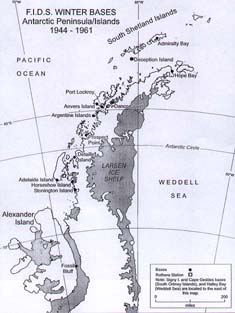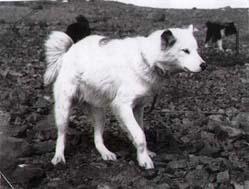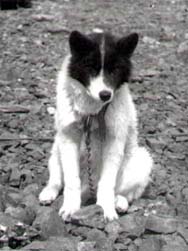Table of Contents
*
Featured Inuit Dog Owner: Merv Ehrich
*
Jubilee Medal Awarded to ISDI Co-Founder
*
Blue Eyes in Norwegian Greenland Dogs
*
ISD Enthusiasts Speak out on Blues Eyes
*
ISDI's Official Stand on Blue Eyes
*
Mountie, Alouette and Moose
*
Following Nanuk's Tracks
*
The Qitdlarssuaq Chronicles, Part 1
*
News Briefs:
New ISDI Scandinavia Web Site
Atanarjuat Update
Dog Teams in Iqaluit
Grammar Lesson
ISDs in Museum Exhibit
*
Poem: Lost Travellers
*
Book Review: first Nations.... first Dogs
*
ISD Enthusiast's First Novel Published
*
IMHO: Seeking to Answer the Wrong Question
Navigating This
Site
Index of articles by subject
Index
of back issues by volume number
Search The
Fan Hitch
Articles
to download and print
Ordering
Ken MacRury's Thesis
Our
comprehensive list of resources
Talk
to The
Fan Hitch
The Fan
Hitch home page
ISDI
home page
Editor: Sue Hamilton
Webmaster: Mark Hamilton
Contents of The Fan Hitch Website and its publications are protected by international copyright laws. No photo, drawing or text may be reproduced in any form without written consent. Webmasters please note: written consent is necessary before linking this site to yours! Please forward requests to Sue Hamilton, 55 Town Line Rd., Harwinton, Connecticut 06791, USA or mail@thefanhitch.org

Courtesy: British Antarctic Survey
Mountie, Alouette and Moose
by Keith Holmes, Oxford, U.K.
In 1965 and 1966 I worked as a Geologist at the British Antarctic Survey's Base E on Stonington Island, on the west coast of the Antarctic Peninsula. At that time Stonington had about a hundred sled dogs which were used as the primary form of transport when making topographic, geological and geophysical surveys.
In retirement, I am now working on a compilation of all the dogs which were owned by the Falkland Islands Dependencies Survey and its successor, the British Antarctic Survey, in the period from 1944 onwards. There were well over a thousand, most of which were born and bred in Antarctica. The founding stock was purchased in Labrador in 1944 and 1945, and there were subsequent infusions of fresh blood from Greenland and other parts of Canada.
Three Canadian youngsters in particular interest me at the moment and I would be pleased to hear from anyone who has any further knowledge of their early days.
The puppies were given to the Falkland Islands Dependencies Survey by the Royal Canadian Mounted Police in 1954. They left Canada by air on October 14, and were transferred to the Survey's ship in Montevideo, Uruguay, for the voyage to Base D at Hope Bay on the Antarctic Peninsula. They arrived on November 17 and in the 1954 Base D Dog Report were described as follows:

Mountie
Courtesy:
British Antarctic Survey
"The three Canadian pups are fine animals. The larger dog (Mountie) and bitch (Alouette) are particularly promising and will probably be quite big animals. They are lankier and lighter than our dogs. The smaller black and white dog (now called Moose) will probably never be as large as the other Canadian dogs."
Each Survey animal had a Dog Card on which records were kept, together with a photograph taken at the age of about twelve months. These indicate that Alouette and Mountie were born in June 1954 at "Craig Harbour in the eastern Canadian Arctic" and belonged to "a Police special called Kayak". Moose was born in July at Arctic Bay on the northern tip of Baffin Island and was owned by "Shappa, a Dorset native".
Alouette did only a limited amount of sledding, and no breeding, because she died of exposure aged two years in a weakened condition owing to an acute shortage of seal meat in 1956. Mountie spent all his working life at Hope Bay and retired to another base as a housedog in March, 1962. He was put down a year later on October 15, 1963 aged nine, when he became too infirm. In his time he traveled thousands of miles in several teams and sired two litters. By contrast, Moose spent only a short time at Hope Bay because he and his team, the Spartans, were soon moved further south to a new base on Horseshoe Island in Marguerite Bay. From there, and the nearby base on Stonington Island, he too sledded thousands of miles. He sired one litter and ended his life far to the south at the small base of Fossil Bluff on the flank of the huge fault valley called King George Sound, which separates Alexander Island from the Antarctic Peninsula. There he too was put down, aged nearly eight, on February 3, 1962. Such were typical lives of the Survey's dogs.
But Moose made news again. In the southern summer of 1999-2000, two men working at Fossil Bluff discovered the bodies of four dogs in old hessian coal sacks. They had ablated to the surface after being buried in a hole in the ice many years before. The collars showed that one of them was Moose. The others were called Pasha, Vicar and Tess. When I heard this I got in touch with a colleague, Cliff Pearce, who had been there forty years before, having in fact been one of the three men who spent the first southern winter at the hut in 1961. By chance, both Cliff and I attended an Antarctic Reunion at Stonington, Connecticut in October 2001.

Moose
Courtesy British
Antarctic Survey
Cliff, who has drafted and hopes to publish a full length account of his Antarctic experience, recalls the Fossil Bluff story as follows:
"Along with Brian Taylor and John Smith, I spent the first winter at Fossil Bluff in 1961. We were to have been joined in early October for the summer sledding program by colleagues from Stonington Island, some 200 miles to the north, and they made a tentative start to the journey across the sea ice in August. However, because of ice problems in Marguerite Bay, the Muskeg tractors and two teams of sled dogs took no less than ninety-three days to cover the distance and didn't reach us until November 24. Moose was one of the Spartan team on that journey.
During the rest of the summer season the dog teams carried out survey work along the Sound but three of them were unfit and had to be left behind at Fossil Bluff. Vicar had a broken leg which never really mended. Pasha was too infirm to work any more, and Tess was very ill - she couldn't eat, hardly drank anything and shivered the whole time. At the base we gave all the dogs much care and attention, and eventually Tess improved, but she was never back to full strength.
On February 1, 1962, at the end of the summer season, John and I flew back to Stonington, and two days later Bill Tracy and Brian Wigglesworth flew with their respective dog teams back to the airbase on Adelaide Island. Before leaving, however, they reluctantly decided to shoot the invalids Vicar, Pasha and Tess, as well as the elderly Moose, who had nevertheless completed all the summer field journeys. He was unlikely to be fit enough for further work. When they buried the dogs in hessian coal sacks and placed them in a hole in the ice, neither Bill nor Brian could have imagined that, forty years later, ablation would expose them all. The day before I left Fossil Bluff I recorded in my diary "...Bill, Brian, Bob and I went to feed them. As usual the dogs exhibit their own personal characteristics. Moose always buries his food; Nu gulps his down in a few seconds; Pongo tears the paper off his and eats it genteelly. They are the most lovable creatures..."
* * *